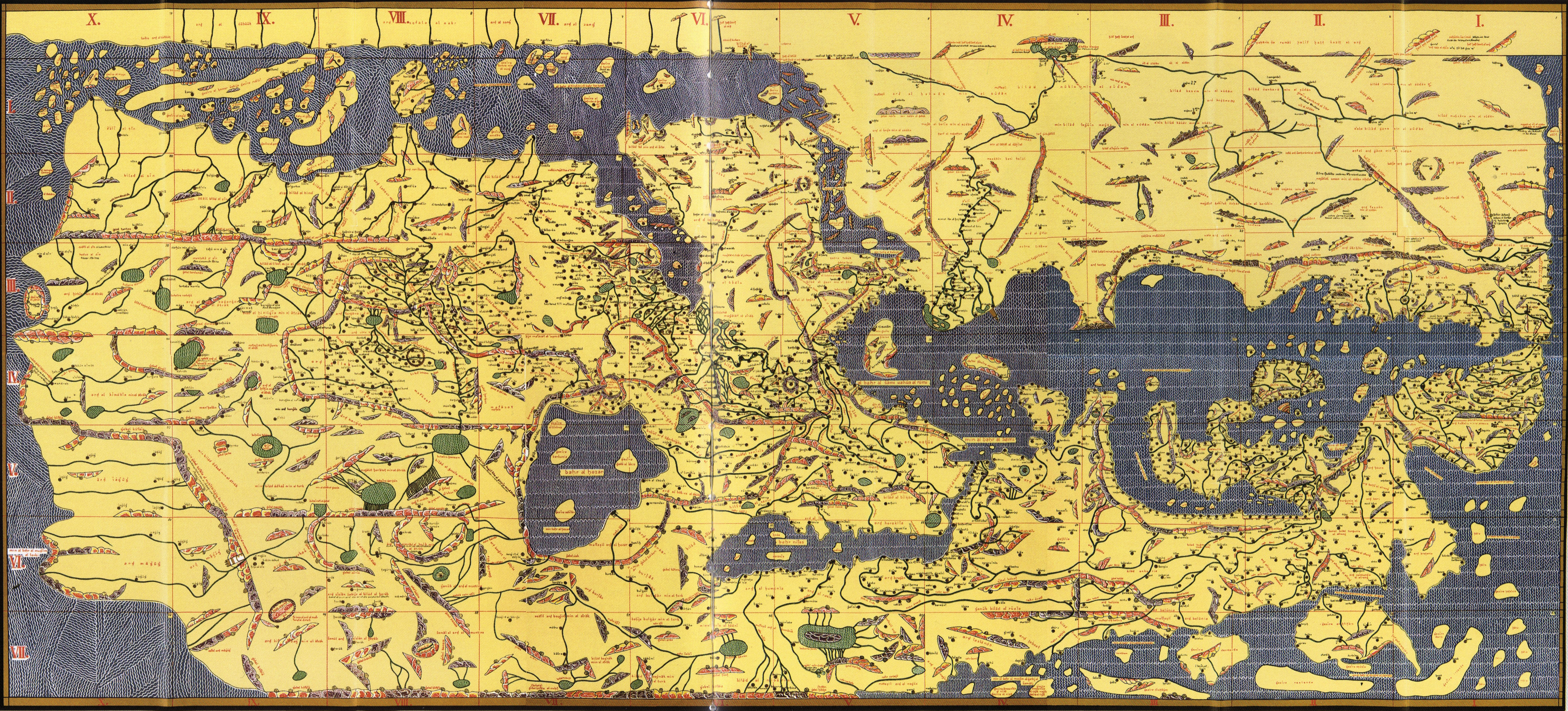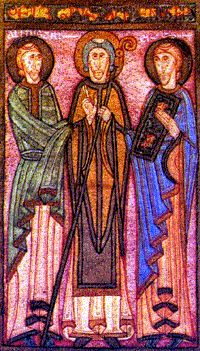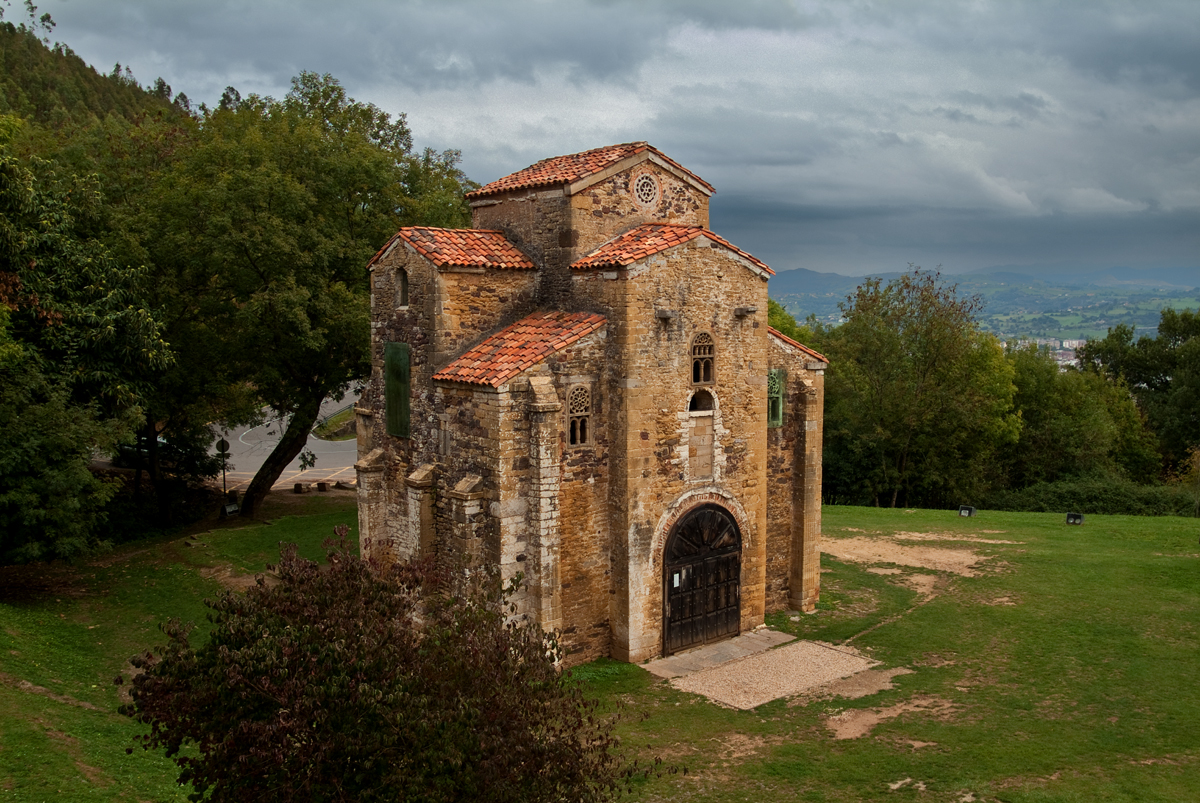|
Elvira Of Castile, Queen Of León
Elvira García (–1017) was Queen of León by marriage to King Bermudo II, and regent of Leon jointly with Count Menendo González during the minority of her son Alfonso V from 999 until 1008. Life Although the year of her birth is not documented, she must have been born shortly before or after 978 since she does not appear with her older sisters, Urraca and Toda, in the foundational charter of the ''Infantado'' of Covarrubias in November 24 of that year. Her husband, Bermudo II of León was her first cousin, if Bermudo's debated filiation as the son of Queen Urraca Fernández is correct.If Bermudo was the son of Urraca Fernández, both were grandchildren of Count Fernán González. The marriage was celebrated near the end of November 991 and both appear together confirming royal charters as of 992. The marriage, which took place after Bermudo repudiated his first wife, Velasquita Ramírez between 988 and 991, sealed an alliance between the Kingdom of León and the County ... [...More Info...] [...Related Items...] OR: [Wikipedia] [Google] [Baidu] |
García Fernández Of Castile
García Fernández, called of the White Hands () (Burgos, Córdoba, 995), was the count of Castile and Alava from 970 to 995. In May 995, he was captured by a raiding party while out hunting. Wounded in the encounter, he was sent to Cordoba as a trophy, but died at Medinaceli in June 995. Family The son of Count Fernán González and Queen Sancha Sánchez of Pamplona, in 970 he succeeded his father as Count of Castile. He continued to recognise the suzerainty of the Kingdom of León, even though he was practically autonomous. In order to expand his frontiers at the expense of the Moors, in 974 he expanded the social base of the nobility by promulgating decrees stating that any villein of Castrojeriz who equipped a knight for battle would enter the ranks of the nobility. He was succeeded by his son, Sancho I of Castile. Marriage and issue Around 960, Garcia married Ava de Ribagorza, daughter of Raymond II, count of Ribagorza. They had seven children: *Mayor García, mar ... [...More Info...] [...Related Items...] OR: [Wikipedia] [Google] [Baidu] |
Mozarabs
The Mozarabs (from ), or more precisely Andalusi Christians, were the Christians of al-Andalus, or the territories of Iberia under Muslim rule from 711 to 1492. Following the Umayyad conquest of the Visigothic Kingdom in Hispania, the Christian population of much of Iberia came under Muslim control. Initially, the vast majority of Mozarabs kept Christianity and their dialects descended from Latin. Gradually, the population converted to Islam—an estimated 50% by the year 951 ''Cited in'' —and was influenced, in varying degrees, by Arab customs and knowledge, and sometimes acquired greater social status in doing so. The local Romance vernaculars, with an important contribution of Arabic and spoken by Christians and Muslims alike, are referred to as Andalusi Romance (also called ''Mozarabic language''). Mozarabs were mostly Catholics of the Visigothic or Mozarabic Rite. Due to Sharia and fiqh being confessional and only applying to Muslims, the Christians paid the jizya tax, ... [...More Info...] [...Related Items...] OR: [Wikipedia] [Google] [Baidu] |
Reinhart Dozy
Reinhart Pieter Anne Dozy (Leiden, Netherlands, 21 February 1820 – Leiden, 29 April 1883) was a Dutch scholar of French (Huguenot) origin, who was born in Leiden. He was an Orientalist scholar of Arabic language, history and literature. Biography The Dozys, like other contemporary French families, emigrated to the Low Countries after the revocation of the edict of Nantes, but some of the former appear to have settled in the Netherlands as early as 1647. Dozy studied at the University of Leiden, obtained the degree of doctor in 1844, was appointed an extraordinary professor of history in 1850, and professor in 1857. Dozy was a correspondent of the Royal Institute between 1848 and 1851. He became a member of the successor institute, the Royal Netherlands Academy of Arts and Sciences, in 1855. Works In 1847 Reinhart Dozy's extensive studies in Oriental literature, Arabic language and history, resulted in his first publication, ''The History of the Almohads, preceded by a Sketc ... [...More Info...] [...Related Items...] OR: [Wikipedia] [Google] [Baidu] |
Almanzor
Abu ʿĀmir Muḥammad ibn ʿAbdullāh ibn Abi ʿĀmir al-Maʿafiri (), nicknamed al-Manṣūr (, "the Victorious"), which is often Latinized as Almanzor in Spanish, Almansor in Catalan language, Catalan and Almançor in Portuguese ( 938 – 8 August 1002), was a Muslim Arab al-Andalus, Andalusi military leader and politician, statesman. As the chancellor of the Caliphate of Córdoba, Umayyad Caliphate of Córdoba and ''hajib'' (chamberlain) for Caliph Hisham II, Almanzor was effectively ruler of Islamic Iberia. Born in Turrush to a family of Yemeni Arab origin with some juridical ancestors, ibn Abi ʿĀmir left for Córdoba, Spain, Córdoba when still young to be trained as a ''faqīh''. After a few humble beginnings, he joined the court administration and soon gained the confidence of Subh of Córdoba, Subh, Umm al-walad, mother of the children of Caliph Al-Hakam II. Thanks to her patronage and his own efficiency, he quickly expanded his role. During the caliphate of Al-Hakam ... [...More Info...] [...Related Items...] OR: [Wikipedia] [Google] [Baidu] |
Ibn Khaldun
Ibn Khaldun (27 May 1332 – 17 March 1406, 732–808 Hijri year, AH) was an Arabs, Arab Islamic scholar, historian, philosopher and sociologist. He is widely acknowledged to be one of the greatest social scientists of the Middle Ages, and considered by a number of scholars to be a major forerunner of historiography, sociology, economics, and demography studies. His best-known book, the ''Muqaddimah'' or ''Prolegomena'' ("Introduction"), which he wrote in six months as he states in his autobiography, influenced 17th-century and 19th-century Ottoman historians such as Kâtip Çelebi, Mustafa Naima and Ahmed Cevdet Pasha, who used its theories to analyze the growth and decline of the Ottoman Empire. Ibn Khaldun interacted with Tamerlane, the founder of the Timurid Empire. He has been called one of the most prominent Muslim and Arab scholars and historians. Recently, Ibn Khaldun's works have been compared with those of influential European philosophers such as Niccolò Machiavelli ... [...More Info...] [...Related Items...] OR: [Wikipedia] [Google] [Baidu] |
Muslim
Muslims () are people who adhere to Islam, a Monotheism, monotheistic religion belonging to the Abrahamic religions, Abrahamic tradition. They consider the Quran, the foundational religious text of Islam, to be the verbatim word of the God in Abrahamic religions, God of Abraham (or ''Allah'') as it was revealed to Muhammad, the last Islamic prophet. Alongside the Quran, Muslims also believe in previous Islamic holy books, revelations, such as the Tawrat (Torah), the Zabur (Psalms), and the Injeel (Gospel). These earlier revelations are associated with Judaism and Christianity, which are regarded by Muslims as earlier versions of Islam. The majority of Muslims also follow the teachings and practices attributed to Muhammad (''sunnah'') as recorded in traditional accounts (hadith). With an estimated population of almost 2 billion followers, Muslims comprise around 26% of the world's total population. In descending order, the percentage of people who identify as Muslims on each ... [...More Info...] [...Related Items...] OR: [Wikipedia] [Google] [Baidu] |
Arabs
Arabs (, , ; , , ) are an ethnic group mainly inhabiting the Arab world in West Asia and North Africa. A significant Arab diaspora is present in various parts of the world. Arabs have been in the Fertile Crescent for thousands of years. In the 9th century BCE, the Assyrians made written references to Arabs as inhabitants of the Levant, Mesopotamia, and Arabia. Throughout the Ancient Near East, Arabs established influential civilizations starting from 3000 BCE onwards, such as Dilmun, Gerrha, and Magan, playing a vital role in trade between Mesopotamia, and the Mediterranean. Other prominent tribes include Midian, ʿĀd, and Thamud mentioned in the Bible and Quran. Later, in 900 BCE, the Qedarites enjoyed close relations with the nearby Canaanite and Aramaean states, and their territory extended from Lower Egypt to the Southern Levant. From 1200 BCE to 110 BCE, powerful kingdoms emerged such as Saba, Lihyan, Minaean, Qataban, Hadhramaut, Awsan, and ... [...More Info...] [...Related Items...] OR: [Wikipedia] [Google] [Baidu] |
Pelagius Of Oviedo
Pelagius (or Pelayo) of Oviedo (died 28 January 1153) was a medieval ecclesiastic, historian, and Forgery, forger who served the Diocese of Oviedo as an auxiliary bishop from 1098 and as bishop from 1102 until his deposition in 1130 and again from 1142 to 1143. He was an active and independent-minded prelate, who zealously defended the privileges and prestige of his diocese. During his episcopal tenure he oversaw the most productive scriptorium in Spain, which produced the vast ''Corpus Pelagianum'', to which Pelagius contributed his own ''Chronicon regum Legionensium'' ("chronicle of the Kings of León"). His work as a historian is generally reliable, but for the forged, interpolated, and otherwise skilfully altered documents that emanated from his office he has been called ''el Fabulador'' ("the Fabulist") and the "prince of falsifiers". It has been suggested that a monument be built in his honour in Oviedo. Life The date and place of Pelagius' birth are unknown. The ''Liber testa ... [...More Info...] [...Related Items...] OR: [Wikipedia] [Google] [Baidu] |
Oviedo
Oviedo () or Uviéu (Asturian language, Asturian: ) is the capital city of the Principality of Asturias in northern Spain and the administrative and commercial centre of the region. It is also the name of the municipality that contains the city. Oviedo is located approximately southwest of Gijón and southeast of Avilés, both of which lie on the shoreline of the Bay of Biscay. Oviedo's proximity to the ocean of less than in combination with its elevated position with areas of the city more than 300 metres above sea level causes the city to have a maritime climate, in spite of its not being located on the shoreline itself. History The Kingdom of Asturias began in 720, with the Visigothic aristocrat Pelagius of Asturias, Pelagius's (685–737) revolt against the Muslims who at the time were occupying most of the Iberian Peninsula. The Umayyad conquest of Hispania, Moorish invasion that began in 711 had taken control of most of the peninsula, until the revolt in the nort ... [...More Info...] [...Related Items...] OR: [Wikipedia] [Google] [Baidu] |
Monastery Of San Pelayo
The Monastery of Saint Pelagius (; ) is a Benedictine convent for women in the city of Oviedo in Spain. The monastery was founded by King Alfonso II of Asturias () and was initially dedicated to John the Baptist. It was only rededicated to Saint Pelagius after it came to acquire his supposed relics in 994. The monastery stands near the cathedral of Oviedo The Metropolitan Cathedral Basilica of the Holy Saviour or Cathedral of San Salvador (, ) is a Roman Catholic church and minor basilica in the centre of Oviedo, in the Asturias region of northern Spain. The Cathedral of San Salvador of Oviedo to .... It was mostly remodeled after the 16th century, losing most of its original Romanesque elements. External links Official page of the monastery Pelayo de Oviedo Monastery of San Pelayo San Pelayo {{Spain-Christian-monastery-stub ... [...More Info...] [...Related Items...] OR: [Wikipedia] [Google] [Baidu] |
Teresa Bermúdez
Teresa Bermúdez or Vermúdez (died 25 April 1039) was a Kingdom of León, Leonese ''infanta'' (royal princess) who became a nun at the monastery of San Pelayo. She is best known for her marriage to a Muslim ruler of Toledo, Spain, Toledo, recorded only in late sources but probably historical. The identity of her husband is not certain. Life Teresa was the daughter of King Bermudo II of León and his second wife, Elvira García. She was born in 991 at the earliest and no later than 993 if she was the first child of her parents' marriage. Teresa was a signatory to at least seven surviving documents, which are the main primary sources for her life. In the first, dated 18 August 1017, she is a witness to her mother's donation to the cathedral of Santiago de Compostela. On 17 December 1017, she and her sister Sancha were engaged in a lawsuit against Osorio Fróilaz over the monastery of Santa Eulalia de Fingoy. On 1 March 1028 and 27 January 1030, she made her own donations to Santiago ... [...More Info...] [...Related Items...] OR: [Wikipedia] [Google] [Baidu] |
León, Spain
León (; ) is a city and Municipalities of Spain, municipality of Spain, capital of the province of León, part of the autonomous community of Castile and León, in the northwest of the Iberian Peninsula. It has a population of 124,303 (2019), by far the largest municipality in the province. The population of the metropolitan area, including the neighbouring San Andrés del Rabanedo and other smaller municipalities, accounts for around 200,000 inhabitants. Founded as the military encampment of the ''Legio VI Victrix'' around 29 BC, its standing as an encampment city was consolidated with the definitive settlement of the ''Legio VII Gemina'' from 74 AD. Following its partial depopulation due to the Umayyad invasion of Hispania, Umayyad conquest of the peninsula, 910 saw the beginning of one of its most prominent historical periods, when it became the capital of the Kingdom of León, which took active part in the Reconquista against the Moors, and came to be one of the fundamenta ... [...More Info...] [...Related Items...] OR: [Wikipedia] [Google] [Baidu] |








